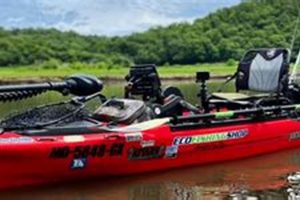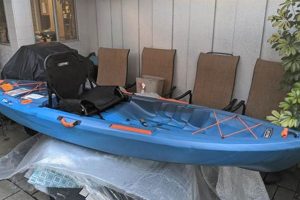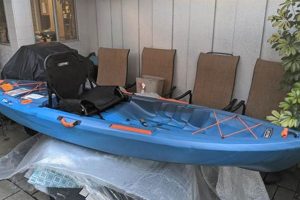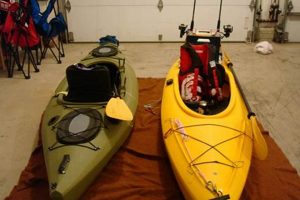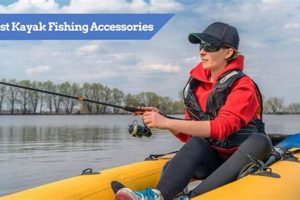Equipment designed specifically for angling from kayaks capable of handling larger game fish typically includes specialized rod holders, reinforced nets, and gear tracks for mounting outriggers or downriggers. These items prioritize durability and functionality to withstand the increased stress and demands of pursuing substantial catches. For example, heavy-duty rod holders with gimbal mounts accommodate larger rods and reels, while reinforced nets with deeper bags and stronger handles prevent fish from escaping.
The use of appropriate equipment is crucial for successful and safe angling for large fish from a kayak. It allows anglers to effectively manage larger, more powerful fish, reducing the risk of equipment failure and improving the chances of landing a trophy catch. Historically, kayak fishing for large fish relied on adapted gear from other angling disciplines. However, the growing popularity of this specialized pursuit has driven the development of purpose-built equipment to meet the unique needs of anglers targeting larger species.
A detailed exploration of individual equipment components, including rod and reel selection, appropriate line and tackle, and safety considerations for kayak anglers targeting big game fish, will follow.
Tips for Effective Kayak Fishing for Large Species
Appropriate equipment selection and strategic angling techniques significantly enhance the likelihood of success when targeting large fish from a kayak.
Tip 1: Choose Specialized Rod Holders: Opt for heavy-duty rod holders designed for larger rods and reels. Gimbal mounts offer superior support and control when battling powerful fish.
Tip 2: Invest in a Reinforced Landing Net: A robust net with a deep bag and a strong handle is essential for securely landing large fish and minimizing the risk of escape.
Tip 3: Utilize Gear Tracks for Mounting Accessories: Gear tracks provide versatile mounting options for downriggers, outriggers, and other specialized equipment designed for larger species.
Tip 4: Select Appropriate Line and Tackle: Heavier line and robust tackle are crucial for handling the increased strength and weight of larger fish.
Tip 5: Prioritize Safety Equipment: A personal flotation device (PFD) and a reliable communication device are essential safety precautions, especially when angling offshore or in challenging conditions.
Tip 6: Practice Proper Fish Handling Techniques: Employ appropriate techniques for handling and releasing large fish to minimize stress on the animal and ensure its survival.
Tip 7: Research Target Species Behavior: Understanding the behavior and habitat preferences of the target species enhances angling effectiveness and increases the chance of a successful catch.
Implementing these strategies significantly increases the likelihood of a successful and safe fishing experience when pursuing large fish from a kayak.
This comprehensive approach to equipment selection and angling techniques provides a solid foundation for success in this demanding yet rewarding pursuit.
1. Rod Holders
Rod holders constitute a critical component of big fish kayak accessories, directly influencing an angler’s ability to successfully target and land large species. These specialized holders provide secure storage and quick access to rods, but more importantly, they offer crucial stability and control when battling powerful fish. Without robust rod holders, anglers face increased risks of losing rods overboard or suffering equipment damage during a fight. Consider a scenario involving a large striped bass striking a trolled lure. The sudden force and subsequent struggle demand a firmly secured rod. A quality rod holder absorbs these stresses, preventing loss of control and potential injury.
Flush-mount, adjustable, and rotating rod holders cater to various angling styles and kayak setups. Flush-mount holders maximize deck space, while adjustable versions offer flexibility for different rod lengths and fishing techniques. Rotating holders allow for quick adjustments to rod angles, optimizing leverage during a fight. Selecting the appropriate rod holder type hinges on factors such as target species, fishing environment, and personal preference. For instance, trolling for offshore species may necessitate heavy-duty rotating holders, whereas inshore fishing might benefit from adjustable or flush-mount options. This nuanced understanding of rod holder selection optimizes fishing effectiveness and equipment longevity.
Strategic rod holder placement further enhances angling efficiency. Positioning holders within easy reach facilitates rapid deployment and retrieval of rods. Anglers frequently position holders to accommodate multiple lines at varying angles, maximizing coverage and strike detection. Careful consideration of rod placement minimizes line tangling and optimizes responsiveness to fish strikes. This strategic approach ultimately contributes to a more successful and enjoyable angling experience, particularly when targeting large, challenging fish from a kayak.
2. Landing Nets
Landing nets represent a crucial component within the broader category of big fish kayak accessories. Their importance stems directly from the challenges and risks associated with bringing large, powerful fish onto a kayak. Without a robust and appropriately sized net, the likelihood of successfully landing a trophy catch diminishes significantly. A large fish, once hooked, exerts considerable force, and attempting to lift it directly onto a kayak presents several hazards. The fish may thrash violently, potentially injuring the angler or damaging the kayak. Furthermore, the hooks can dislodge during the struggle, resulting in a lost catch. A landing net mitigates these risks by providing a safe and controlled means of securing the fish alongside the kayak.
Consider the scenario of hooking a large tarpon from a kayak. These powerful fish are known for their acrobatic leaps and determined fights. Attempting to land a tarpon without a net often results in a prolonged struggle, increasing the risk of the fish throwing the hook or the angler losing balance. A sturdy landing net with a wide hoop and deep mesh allows the angler to quickly scoop the exhausted fish, minimizing the duration of the fight and ensuring a safe and successful landing. The net’s design also prevents the fish from becoming entangled in the kayak’s rigging, further reducing the risk of complications. Furthermore, a rubberized net minimizes damage to the fish’s delicate slime coat, promoting healthy catch-and-release practices.
Selecting the appropriate landing net hinges on several factors, including the target species, the size and stability of the kayak, and the angler’s experience level. Larger fish necessitate nets with correspondingly larger hoops and deeper bags. Kayak anglers often prefer nets with telescoping handles for compact storage and extended reach. The net’s construction material also influences its durability and resistance to corrosion in saltwater environments. Ultimately, the careful selection and effective utilization of a landing net significantly contribute to a safe and successful kayak fishing experience when targeting large game fish.
3. Gear Tracks
Gear tracks represent a fundamental component within the realm of big fish kayak accessories, offering versatile mounting solutions for essential equipment. These tracks, typically installed along the gunwales or within the cockpit area of a kayak, provide standardized mounting points for a variety of accessories, including rod holders, fish finders, GPS units, camera mounts, and importantly, outriggers and downriggers. This adaptability is particularly crucial when targeting large fish species, as it allows anglers to customize their kayak setup to match the specific demands of the pursuit. For instance, an angler targeting large pelagic fish might utilize gear tracks to mount a downrigger for precise bait presentation at depth, while an inshore angler pursuing large redfish might opt for strategically positioned rod holders facilitated by the track system.
The practical significance of gear tracks becomes evident when considering the dynamic nature of big game fishing. Rapid adjustments to equipment positioning often prove essential during a fight with a powerful fish. Gear tracks enable anglers to quickly reposition rod holders, adjust the angle of outriggers, or relocate fish finders for optimal viewing. This adaptability enhances angling efficiency and contributes to a safer and more controlled experience. Imagine battling a large tuna from a kayak; the ability to quickly adjust rod angles or shift the position of a camera mount can be crucial for maintaining leverage and capturing the experience. Without gear tracks, these adjustments would be cumbersome or impossible, potentially jeopardizing the success of the landing.
Effective utilization of gear tracks requires careful consideration of kayak layout and target species. Anglers should strategically position tracks to maximize accessibility and minimize interference with paddling or other essential activities. Furthermore, selecting compatible mounts and accessories ensures a secure and reliable setup capable of withstanding the stresses exerted by large fish. Understanding the potential of gear tracks to enhance versatility and adaptability is crucial for anglers seeking to maximize their success when targeting trophy fish from a kayak.
4. Tackle Selection
Tackle selection represents a critical aspect of big fish kayak accessories, directly influencing an angler’s ability to successfully hook, fight, and land large, powerful species. The connection between appropriate tackle and kayak fishing for big game stems from the unique challenges presented by this specialized pursuit. Kayak anglers face inherent limitations in terms of space, stability, and leverage, necessitating tackle choices that maximize efficiency and control while minimizing risk. Selecting tackle inappropriate for the target species or the fishing environment significantly increases the likelihood of equipment failure, lost fish, or even angler injury. For instance, using light line and small hooks when targeting large, powerful fish like tuna or marlin invites disaster. The inadequate tackle risks breaking under pressure, resulting in a lost fish and potentially jeopardizing the angler’s safety.
Specific tackle considerations for big fish kayak anglers include line strength, hook size and type, leader material, and lure or bait selection. Heavier lines, typically braided lines with high tensile strength, are essential for handling the powerful runs and aggressive fights of large fish. Hook size and type should match the target species and the chosen bait or lure. Strong, abrasion-resistant leader material is crucial, particularly when fishing near structure or targeting species with sharp teeth. Lure selection depends on the target species’ feeding habits and the prevailing fishing conditions. Live bait, large artificial lures, or specialized trolling rigs often prove effective for enticing large game fish. For example, when trolling for offshore species like mahi-mahi, heavy-duty trolling lures with strong hooks and robust leader material are essential for withstanding the high speeds and aggressive strikes. Conversely, targeting large inshore species like snook or redfish may require lighter tackle and more finesse-oriented presentations.
Understanding the nuanced relationship between tackle selection and the specific demands of big fish kayak angling is paramount for success. Appropriate tackle enhances an angler’s ability to effectively target and land trophy fish while ensuring a safe and controlled fishing experience. Failure to carefully consider tackle choices can lead to frustration, lost opportunities, and potentially hazardous situations. Therefore, meticulous tackle selection stands as a cornerstone of responsible and successful big fish kayak fishing.
5. Safety Gear
Safety gear constitutes an indispensable component of big fish kayak accessories, inextricably linked to the inherent risks associated with pursuing large, powerful species in a relatively small and unstable vessel. This connection stems from the potential for sudden, forceful movements by the fish, unpredictable weather conditions, and the possibility of capsizing or other on-the-water emergencies. A large fish, once hooked, exerts considerable force, capable of pulling an angler off balance or even capsizing the kayak. Furthermore, the offshore environments often targeted for large game fish present additional hazards such as changing weather patterns, strong currents, and potential encounters with other vessels. Neglecting safety gear in these dynamic and potentially hazardous conditions elevates the risk of serious injury or even fatality. For example, an angler battling a large marlin offshore without a personal flotation device (PFD) faces significant danger in the event of a capsize or being pulled overboard. Similarly, a lack of communication equipment can prove disastrous if the angler experiences an emergency far from shore.
Specific safety equipment essential for big fish kayak anglers includes PFDs, communication devices, visual distress signals, and first-aid kits. A properly fitted PFD provides essential buoyancy in the event of a capsize, significantly increasing the chances of survival. Communication devices, such as VHF radios or satellite phones, enable anglers to contact emergency services or other vessels in case of distress. Visual distress signals, including flares and signal mirrors, can attract attention over long distances. A comprehensive first-aid kit allows for immediate treatment of minor injuries or stabilization of more serious injuries until professional medical assistance can be obtained. Consider the scenario of a kayak angler hooking a large tuna far offshore. A sudden change in weather conditions creates rough seas, and the angler capsizes during the fight. A PFD ensures the angler remains afloat, a VHF radio allows for communication with the Coast Guard, and a signal mirror aids in attracting the attention of rescuers. Without these essential safety items, the outcome of this scenario could be drastically different.
Prioritizing safety gear demonstrates responsible angling practices and significantly mitigates the inherent risks associated with big fish kayak fishing. The potential consequences of neglecting safety precautions underscore the crucial role of these items in ensuring a safe and enjoyable angling experience. While specialized fishing equipment enhances the pursuit of large fish, safety gear serves as the foundation upon which a successful and safe outing rests. Understanding this fundamental connection and investing in appropriate safety equipment should be paramount for any angler venturing offshore or targeting large, powerful species from a kayak.
Frequently Asked Questions
Addressing common inquiries regarding equipment for pursuing large fish from a kayak clarifies essential considerations for anglers.
Question 1: What differentiates standard kayak fishing accessories from those designed for large fish?
Equipment designed for large fish prioritizes durability and strength. Reinforced construction, robust materials, and specialized features, such as heavy-duty rod holders and larger nets, accommodate the increased stress and demands of battling powerful fish.
Question 2: Are specialized accessories essential for targeting large fish from a kayak?
While adaptation of existing equipment is possible, purpose-built accessories significantly enhance safety and effectiveness. They mitigate the risks associated with handling powerful fish in a kayak environment.
Question 3: How does rod holder selection influence success when fishing for large species?
Robust rod holders, often featuring gimbal mounts, provide essential stability and control. They prevent rod loss or damage during intense fights and facilitate precise rod positioning for optimal leverage.
Question 4: What factors should guide landing net selection for kayak anglers targeting big fish?
Net size, handle length, and mesh material should align with the target species and kayak dimensions. Larger nets with telescoping handles and durable, corrosion-resistant mesh are generally preferred.
Question 5: Why are gear tracks important for customizing a kayak for large fish?
Gear tracks offer versatile mounting points for various accessories, enabling anglers to tailor their kayak setup for specific fishing styles and target species. This adaptability enhances both efficiency and safety.
Question 6: How does appropriate tackle selection contribute to successful big fish kayak angling?
Heavy-duty lines, robust hooks, and strong leader material are crucial for withstanding the powerful runs and aggressive fights of large fish. Tackle selection should align with the target species and fishing environment.
Careful consideration of these frequently asked questions underscores the importance of selecting appropriate accessories to optimize safety, effectiveness, and enjoyment when pursuing large fish from a kayak.
Practical tips for selecting and utilizing these accessories will be explored in the next section.
Big Fish Kayak Accessories
Specialized equipment designed for pursuing large fish from a kayak represents a significant advancement in angling technology. This discussion explored the crucial role of appropriate rod holders, robust landing nets, versatile gear tracks, strategic tackle selection, and essential safety gear in enhancing both the effectiveness and safety of this demanding pursuit. Careful consideration of these elements empowers anglers to confidently target trophy fish while mitigating the inherent risks of battling powerful species from a small, relatively unstable platform.
Ultimately, the evolution of big fish kayak accessories reflects the growing popularity and increasing specialization within the sport of kayak fishing. As anglers continue to push the boundaries of this exciting pursuit, further refinement of specialized equipment will undoubtedly contribute to enhanced angling experiences and promote responsible interactions with the aquatic environment.


